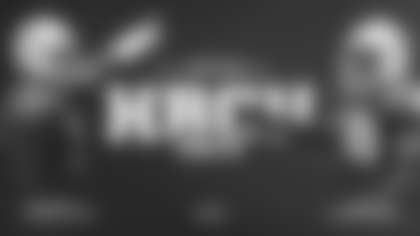INDIANAPOLIS — The 2019 NFL Scouting Combine, which featured more than 330 draft hopefuls, officially wrapped up on Monday. However, there are many players who weren't in attendance this year that will still be drafted and will make an impact in the NFL.
During last year's draft, 38 players who were not invited to the Combine were still drafted, while more than a third of the prospects who were in attendance at the Combine were not selected, according to Arnie Stapleton of The Associated Press. The Colts, for example, ended up selecting three players last year who were not invited to the Combine: wide receiver Daurice Fountain and linebackers Matthew Adams and Zaire Franklin.
While everyone who participates in the Combine was invited for a reason, this year's class comes with no shortage of outstanding draft-eligible collegiate player who were "snubbed" from performing at this year's event. Those players will instead need to rely on workouts, pro days and interviews to show teams what they've got.
Here are some of the top players to look out for this draft season who were not in attendance at this year's Combine.
RB BRUCE ANDERSON, NORTH DAKOTA STATE
If Anderson was from a bigger program than NDSU then he'd likely be a higher-regarded prospect, even in this deep class of running backs. He doesn't have any glaring weaknesses and is capable of doing everything a three-down back is asked to do. The playmaker totaled 2,495 yards of offense and 27 touchdowns over the last two seasons, and was lauded for his ball security by Matt Waldman of The Rookie Scouting Portfolio.
DL MICHAEL DOGBE, TEMPLE
A versatile, powerful lineman, Dogbe proved to be a disruptive force up front for Temple's defense. He moves well for a big man and shows good technique, so he should be pretty easy for coaches to work with. Dogbe could be an underrated, polished find for teams looking to add a rotational piece to their defensive line late in the draft.
WR PENNY HART, GEORGIA STATE
Hart was among the more surprising snubs after a strong showing at the Senior Bowl a month ago. Although small in stature at 5-8 and 180 pounds, he is a fast, lightning-quick player who proved that those skills can translate to his route running. Oftentimes, these types of players are looked at as gadget players or return specialists, but Hart has shown plenty to indicate he could actually make an impact as a receiver as well.
LB KHALIL HODGE, BUFFALO
Many people argue that linebacker is the weakest position group in this year's draft class, and Hodge is often considered one of the more promising prospects at the position, so his exclusion was a bit surprising as well. Hodge is a tackling machine, finishing 13th, second and fifth nationally in tackles, respectively, over the last three seasons. He can cover in the pass game and diagnoses the run as well as anyone in this class.
RB DEVINE OZIGBO, NEBRASKA
Perhaps this year's biggest snub, Ozigbo fits the mold of the tough, productive Big Ten running back. However, he's not just a straight-forward, head-down chain mover. Although he's about 6-2, 230, Ozigbo's added elusivity and ability to catch the ball out of the backfield makes him a player who presents the total package as a runner. He's proved as much in this year's East-West Shrine Game.
TE DONALD PARHAM, STETSON
You've probably never heard of Parham's school, Stetson, but he showed that he was no slouch when he went up against better competition at the Senior Bowl. He's huge, measuring in at 6-8, 243, but he's more of a "joker" tight end who specializes in receiving and not so much blocking. With that frame, coaches will certainly try and get some blocking out of him, but it's hard not to see his frame and athletic attributes on not want to work with him.
OL TERRONNE PRESCOD, N.C. STATE
Prescod has displayed the ability to manhandle defensive linemen and is what you'd refer to as a "road grader." He sometimes dwarfs his competition at 6-5 and 331 pounds. On top of all that, he moves generally well, but an NFL nutrition program should help gain extra mobility.
WR ANTHONY RATLIFF-WILLIAMS, NORTH CAROLINA
Ratliff-Williams has shown growth as a prospect in his time at Chapel Hill, becoming a better route runner to go along with his abilities as a tough player with the ball in his hands, which also proves obvious as a kickoff returner. Ratliff-Williams has adequate speed and can be placed anywhere as a receiver in the offensive alignment. He truly appears to be an ascending player with his best days ahead of him.
DE MALIK REED, NEVADA
Reed is a versatile player who began his collegiate career as a defensive end but then moved to linebacker, continuing to showcase his pass-rush prowess. He is a speed rusher with plenty of bend around the edge, who also has good productivity in his career, totaling 38.5 tackles for loss and 22.0 sacks. Reed had a really good week at the NFLPA Bowl and is expected to potentially be a late-round/undrafted gem.
RB DARWIN THOMPSON, UTAH STATE
Another running back to seal the list, Thompson is the type of small (5-8, 190), but speedy back that teams do what they can to get the ball in his hands out in space. However, he was still productive as a full-time runner, putting up 1,044 yards on the ground in 2018. He would have been expected to perform well at the Combine, as The Athletic's Bruce Feldman reported that Thompson has posted a 40.5-inch vertical and can run in the low 4.4s in the 40-yard dash.
While not being able to put your skills on display at the Combine certainly is not helpful for a player's draft stock in the short term, what happens in their career is still very much up to them, as proven by this note from "The Godfather of Scouting," Gil Brandt:
A couple of standouts from last year's rookie class who made an impact despite not being in attendance at the Combine were Oakland Raiders second-round pick P.J. Hall and Denver Broncos undrafted free agent running back Phillip Lindsay.
Hall started six-of-14 games for the Raiders, totaling 22 tackles (three for loss), and Lindsay finished ninth in the NFL in rushing yards with 1,037.















